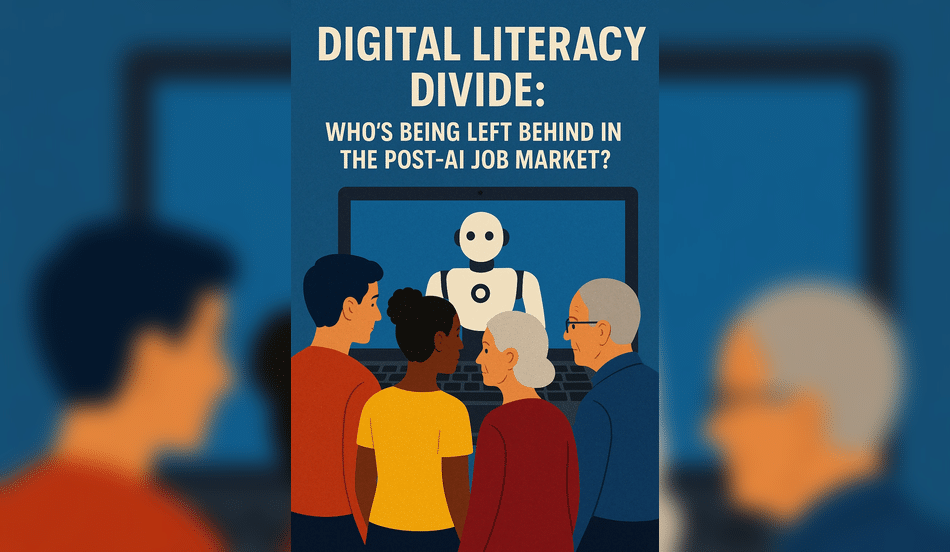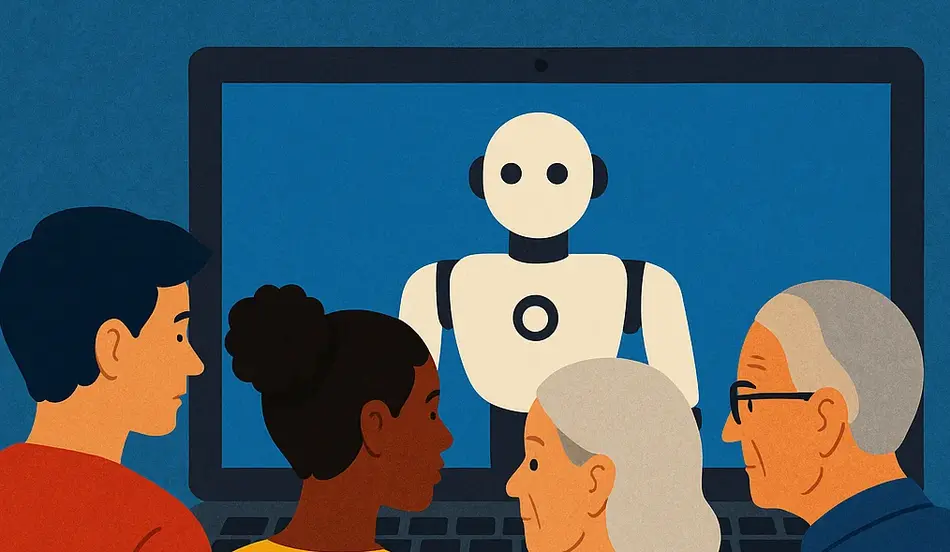In 2025, as artificial intelligence (AI) and automation permeate every industry, a new barrier has emerged: the digital divide. Employers across sectors now expect workers to navigate complex software, collaborate seamlessly via cloud platforms, and interpret data-driven insights. Yet millions of Americans lack even basic digital skills threatening to lock out older adults, low-income households, rural residents, and other vulnerable groups from the jobs powering the post-AI economy.
Table of Contents
The Scale of the Digital Literacy Divide
A 2021 Pew Research Center survey found that 40% of U.S. adults struggle with fundamental digital tasks—such as sending email attachments or filling out online forms—skills now essential for applying to jobs, accessing telehealth, and participating in remote learning. Although 95% of adults use the internet and 80% have home broadband, confidence and competence vary sharply:
- Older Adults: Only 61% of those age 65+ feel “very confident” using digital tools, compared to 87% of 18- to 29-year-olds.
- Low-Income Households: Among families earning under $30,000/year, 44% lack home broadband—over three times the rate of higher-income peers.
- Rural Residents: Limited infrastructure and fewer local training opportunities leave rural Americans 10–15 points behind urban counterparts in digital-skills assessments.
These foundational gaps block access not only to entry-level office roles but also to new positions such as AI-data annotators, customer-support specialists, and digital-marketing assistants—jobs that increasingly form the backbone of the modern economy.
Why Digital Fluency Matters in an AI Era
The World Economic Forum’s Future of Jobs Report 2025 warns that 39% of core skill sets will become outdated by 2030 due to AI, big data, and automation—while 50% of workers have already undertaken reskilling initiatives, up from 41% in 2023. However, effective upskilling presumes a digital foundation: comfort with videoconferencing, collaboration suites, and online learning platforms. Without these basics, workers risk falling further behind as employers demand:
- Cloud Collaboration: Proficiency in tools like Microsoft Teams, Slack, and Google Workspace for real-time teamwork.
- Data Interpretation: Ability to read dashboards, extract insights, and apply them to workflows.
- Digital Security: Recognizing phishing attempts, managing strong passwords, and safeguarding personal data.
Without such capabilities, even well-intentioned reskilling programs can miss their mark.

Industry Perspectives on the Gap
Innovation-driven sectors frequently cite digital-skills shortages among incumbent staff:
- Sustainability & Clean Tech: Over two-thirds of executives report a “moderate-to-extreme” skills gap—jeopardizing climate-tech deployments and grid modernization.
- Healthcare Technology: Telehealth platforms struggle when providers and patients alike lack digital confidence, undermining remote-care adoption.
- Financial Services: Banks and insurers note entry-level hires often lack spreadsheet and CRM proficiency, despite relevant degrees.
These findings underscore that formal credentials no longer guarantee workplace readiness in a digital era and that the gap spans both “white-collar” and “blue-collar” industries alike.
Infrastructure Initiatives: Beyond Broadband
Federal programs aim to close access gaps—but connectivity alone is insufficient:
- BEAD Program: The Broadband Equity, Access, and Deployment initiative directs $42.5 billion toward high-speed internet expansion in underserved areas. However, state-level implementation delays have slowed rollout.
- Affordable Connectivity Program (ACP): Subsidizes $30/month broadband for low-income households, yet funding shortfalls threaten service continuity for millions.
- Digital Equity Act: Provides $2.75 billion for community-based digital-literacy grants, now jeopardized by funding debates at the federal level.
Without pairing connectivity with robust training—in libraries, community centers, and schools—newly connected households may still lack the skills to leverage broadband for work, education, and civic engagement.
Workforce Development & Reskilling Programs
Public-Private Training Hubs
Community colleges, workforce boards, and employers collaborate through WIOA grants to deliver short bootcamps teaching digital essentials—email, spreadsheets, and virtual-meeting tools—alongside career coaching and job-placement assistance.
Micro-Credentialing & Badging
Platforms like IBM’s SkillsBuild offer 1,000+ free courses in AI, cybersecurity, and data analysis, delivered in 20 languages and reaching over 2 million learners globally. Digital badges validate skills to employers, enabling learners to showcase competencies regardless of traditional resumes.
Community Outreach
Nonprofits and public libraries host “tech cafés,” senior citizen tutorials, and peer-mentor networks. In New York’s rural counties, volunteer-led coaching programs help seniors master telehealth portals and online job applications, boosting local employment applications by double digits.
Employer-Led Best Practices
- Baseline Skills Assessment: Deploy quick digital-readiness surveys to tailor training curricula rather than using one-size-fits-all approaches.
- Integrated Soft-Skills & Tech Modules: Combine communication and problem-solving workshops with hands-on tool instruction to maximize learning transfer.
- On-the-Job Mentorship: Pair digitally fluent “champions” with novices on live projects to foster peer-to-peer learning and retention.
- Flexible Delivery: Offer micro-learning videos, evening/weekend workshops, and mobile-optimized content to accommodate diverse schedules and learning styles.
Case Study: South Texas Digital Navigators
In the Rio Grande Valley, a coalition of the University of Texas, local nonprofits, and municipal government launched a Digital Navigators pilot—training 200 community volunteers to deliver one-on-one digital coaching in homes and community centers. Within six months:
- Participant Confidence in online job portals rose from 35% to 78%.
- Local Unemployment Applications dropped by 8% among those served, as residents applied successfully for remote and hybrid roles.
- This model underscores the power of combining grassroots outreach with structured training resources.
Global Comparisons: What We Can Learn
Countries like Estonia and Singapore, long leaders in digital government services, invest heavily in continuous digital-skills education—mandatory coding in schools, ubiquitous e-learning platforms, and national digital-literacy benchmarks. U.S. policymakers and educators can adapt these best practices to domestic contexts, focusing on lifelong learning and public-private partnerships.
The Economic and Social Stakes
Without urgent action, the digital literacy divide risks deepening socioeconomic inequities. Jobs in AI-enabled healthcare, advanced manufacturing, and logistics increasingly demand digital competencies—yet those lacking basic skills will be sidelined. This not only undermines individual prospects but hampers national competitiveness: the digital economy is growing six times faster than traditional sectors and is projected to reach 25% of global GDP by 2030.
Bridging this divide is thus both a matter of social equity and economic necessity. A more digitally literate workforce can:
- Boost Productivity: Workers who master digital tools complete tasks more efficiently and accurately.
- Drive Innovation: Digital fluency encourages creative problem solving and faster adoption of new technologies.
- Expand Access: Equitable digital skills enable wider participation in remote, hybrid, and gig economy roles.
Conclusion
Bridging the digital literacy divide is a shared imperative—requiring coordinated policy, community engagement, and employer leadership. By ensuring all Americans can navigate the digital landscape—from basic email to AI-augmented workflows—the U.S. can fully harness the promise of automation for inclusive economic growth.
For ongoing coverage of digital-skills initiatives, AI workforce trends, and career resources, visit WhatJobs News.
FAQs
Q: What exactly is digital literacy?
A: The ability to use digital devices, communication applications, and networks to access information, perform tasks, solve problems, and create content—ranging from sending emails to analyzing data dashboards.
Q: Why is digital literacy critical in an AI era?
A: AI tools often require users to install software, navigate cloud platforms, evaluate AI outputs, and integrate insights into workflows—competencies contingent on foundational digital skills.
Q: Who is most at risk of being left behind?
A: Older adults, low-income households, rural and tribal communities, non–English speakers, and workers without postsecondary education.
Q: Which policies help close the gap?
A: Federal initiatives like the BEAD Program, Affordable Connectivity Program, and Digital Equity Act improve connectivity and fund training. Public–private partnerships and corporate programs (e.g., IBM SkillsBuild) deliver scalable digital-skills modules.




